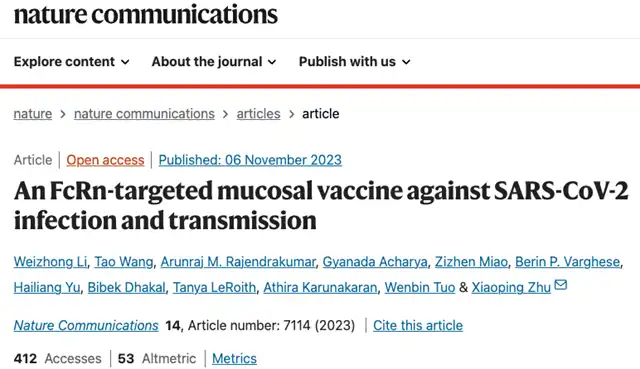University of Maryland’s Nasal Spray Vaccine Against COVID-19 Transmission
- Normal Liver Cells Found to Promote Cancer Metastasis to the Liver
- Nearly 80% Complete Remission: Breakthrough in ADC Anti-Tumor Treatment
- Vaccination Against Common Diseases May Prevent Dementia!
- New Alzheimer’s Disease (AD) Diagnosis and Staging Criteria
- Breakthrough in Alzheimer’s Disease: New Nasal Spray Halts Cognitive Decline by Targeting Toxic Protein
- Can the Tap Water at the Paris Olympics be Drunk Directly?
University of Maryland’s Nasal Spray Vaccine Against COVID-19 Transmission
- Should China be held legally responsible for the US’s $18 trillion COVID losses?
- CT Radiation Exposure Linked to Blood Cancer in Children and Adolescents
- FDA has mandated a top-level black box warning for all marketed CAR-T therapies
- Can people with high blood pressure eat peanuts?
- What is the difference between dopamine and dobutamine?
- How long can the patient live after heart stent surgery?
University of Maryland’s Nasal Spray Vaccine Against COVID-19 Transmission
On November 6, 2023, a research team from the University of Maryland in the United States developed a nasal spray vaccine that delivered the spike protein of SARS-CoV-2 into the airway cells of mice and hamsters, triggering an immune response that significantly reduced COVID-19 infection and transmission.
This technology could be used to induce immunity against other respiratory diseases such as influenza and respiratory syncytial virus infections.
Nasal vaccines represent a significant advancement in preventing respiratory viruses as they are less invasive and can halt viral replication in the airways before particles enter the bloodstream. This holds the potential to increase vaccination rates and reduce disease transmission.
The research findings were published online on November 6, 2023, in the journal Nature Communications.

Dr. Xiaoping Zhu, a veterinary medicine professor at the University of Maryland and the lead author of the study, stated, “The emergence of new variants and successive waves of new pandemics necessitates an easily administrable vaccine that can halt virus transmission. This nasal vaccine can prevent the spread of the virus and can easily adapt to new variants.”
The SARS-CoV-2 virus enters the body through the nasal or oral cavity and replicates within epithelial cells, which act as a protective barrier between the internal and external environments. Injectable vaccines primarily generate immunity in the bloodstream, meaning the virus must enter the body and replicate in the blood before being detected by the immune system. However, the new nasal vaccine can generate immunity in cells of the nasal, oral, and throat areas, thereby stopping the virus from spreading earlier.
Dr. Xiaoping Zhu and the team utilized the body’s natural mechanisms to deliver the COVID-19 spike protein into airway cells, allowing the local immune system to recognize the virus.
They employed a mechanism involving a protein called neonatal Fc receptor (FcRn) to transport antibodies across epithelial cells. Researchers developed and applied a technique that combined selected human antibodies with FcRn. In this study, they combined the spike protein from SARS-CoV-2 with FcRn and sprayed it into the noses of mice, activating the immune response.

Figure Expression and characterization of Spike and pre-fusion Spike-Fc (S-Fc) proteins
The team then exposed mice to the ancestral SARS-CoV-2, Delta variant, and Omicron variant viruses. All unvaccinated mice exposed to the Delta variant died, while the majority of vaccinated mice (83-100%) survived. While mice exposed to the primary Omicron variant survived, the vaccinated mice exhibited significantly reduced inflammation and viral load compared to the unvaccinated ones.

Figure S-Fc Intranasal immunization induces protective immunity against intranasal challenge with the original strain of SARS-CoV-2
The researchers observed that the nasal vaccine triggered a more potent immune response in the airways and lungs compared to muscle injection vaccines. Furthermore, the nasal vaccine (but not the muscle injection vaccine) notably reduced airborne transmission of SARS-CoV-2. This is crucial as inhalation is a primary route of COVID-19 transmission, and virus particles in the air can linger for up to 9 to 12 hours.

Figure FcRn-mediated intranasal vaccination significantly induces respiratory S protein-specific local immune responses
As new variants continue to emerge, COVID-19 cases and hospitalizations are once again on the rise. While updated mRNA vaccines remain effective in preventing severe illness and death, their efficacy in reducing infection and transmission may decrease over time. To bridge this gap, the U.S. government’s “NextGen project” aims to develop an effective and safe nasal vaccine to control the spread of variants. According to Zhu, the nasal vaccine developed by him and his team meets all the criteria of the “NextGen project.”
Reference: [Nature Communications Article](https://www.nature.com/articles/s41467-023-42796-0)
University of Maryland’s Nasal Spray Vaccine Against COVID-19 Transmission
(source:internet, reference only)
Disclaimer of medicaltrend.org
Important Note: The information provided is for informational purposes only and should not be considered as medical advice.



